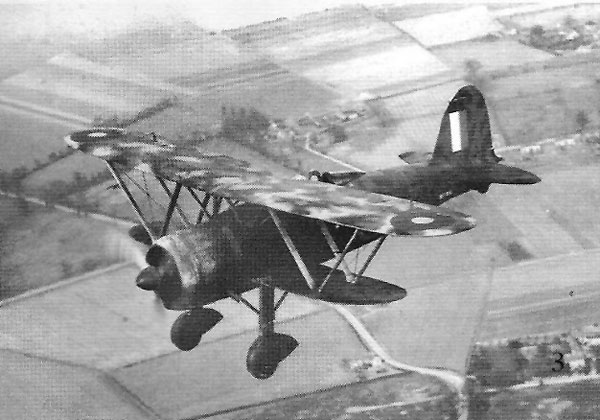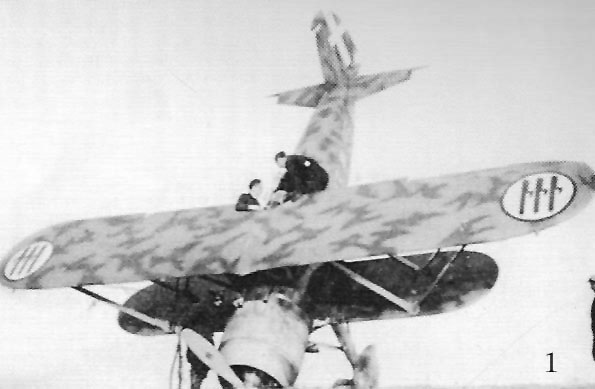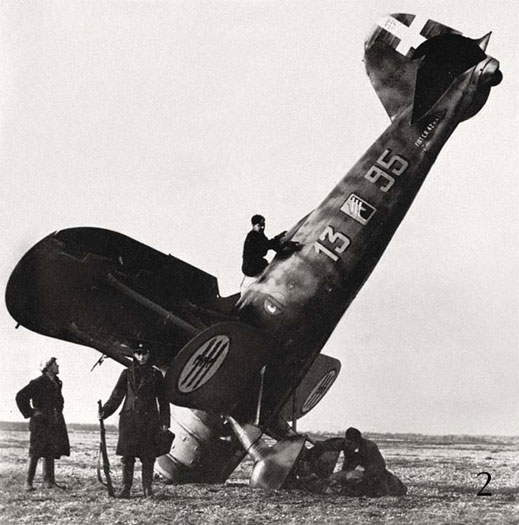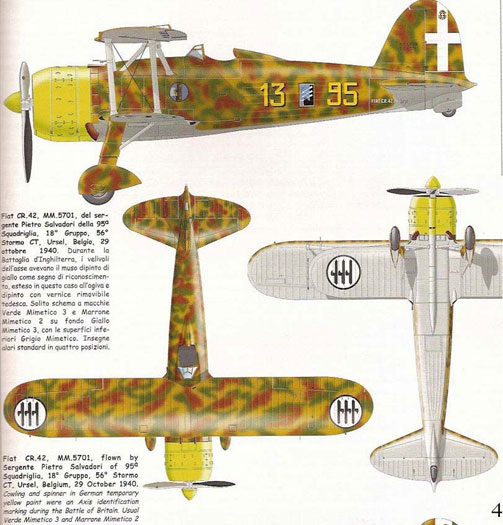|
A Re-evaluation of
Regia Aeronautica Camouflage 1940

by Steven "Modeldad" Eisenman

HyperScale is proudly supported by Squadron
|
Regia Aeronautica Camouflage 1940 |
One of the great challenges of modeling historic aircraft
and in the study of aircraft camouflage is that often fact becomes myth and myth
becomes fact. Take, for example, the old "fact" that (some) Luftwaffe aircraft
were painted in a single color green. This then became myth, and the fact was
that no Luftwaffe aircraft would be a single green. Now the fact has become
myth and the myth becomes fact. It has been documented that some Luftwaffe
aircraft were painted a single green, the Bf 109D for example. Then
there was the underside of P-40s destined for the RAF. The fact once was that
the underside was a “Sky” color, or perhaps Sky Blue. The fact now is that it
was “Sky Grey”.
In trying to separate fact from myth, serendipity can often
be a great research tool. Not long after I posted on HyperScale a response to a
question regarding the camouflage on the CR 42 in the RAF Museum at Hendon, I
was looking through Vol. 2 Section 4 of the Classic Publications’ Jagdwaffe
series, Battle of Britain Phase Four, on an unrelated research issue. I came
upon the few pages in that volume on the Regia Aeronautica’s involvement in the
Battle of Britain.
On page 314 is a picture of a CR 42 with its nose in the
ground. According to the caption, this is MM6976 (NOTE: this is a typographical
error, it should be MM5701), coded 95-13 (or 13-95, Squadron number was carried
in the back) flown by Sargente Pietro Salvadori. On 11 November 1940, Sargente
Salvadori’s aircraft overheated due to an oil line failure and he was forced to
land in England at Orfordness. This is the CR 42 that is at Hendon.

Looking at the picture, I was of the opinion that a single
colored (dark green?), jagged camouflage mottle was applied to the base color on
the upper surfaces of the upper and lower wings. Based on another picture I
found of 13-95, the pattern on the fuselage appears to be a softer and denser
style of mottle, clearly not as “jagged’ as the pattern on the wings. As to the
color, it also could be a single color green (Verde) or two colors, green
(Verde) and reddish-brown (Marrone).
The camouflage pattern on the CR 42 in the Jagdwaffe volume
is nothing like the pattern that is currently applied to the CR 42 in Hendon.
The dark jagged pattern is much larger and there is more space among the pattern
pieces. The camouflage on the fuselage is quite different also.

I then took out Part I of Regia Aeronautica Caccia &
Assulto by Waldis and De Bortoli. This is the first part in a two part series
that is a very comprehensive monograph on RA camouflage and marking from 1940 to
1943.
On page 23 is a profile of a CR 42 with the serial MM5701
and coded 13-95, the same one as in the Jagdwaffe monograph. The aircraft is
pictured as it was on 29 October 1940. It is shown in the “typical” pattern of
Giallo 3 base color, with Verde 3 and Marrone 2 mottle densely applied over the
entire airframe. The pattern on the wing-tops differs only in that the two
mottle colors appear to be more elongated, rather than being oval in shape, as
on the fuselage. The underside is said to be Grigio (Grey). While I could not
be sure about the colors, it was quite clear that the wing-top pattern was not
the same as on the aircraft in the photograph.

According to Waldis and De Bortoli, this aircraft belonged
to Sargente Pietro Slavadori, who, on 11 November 1940 became disoriented in
fog, ran out of fuel and landed at Orfordness. Could poor Sargente Salavadori
have crashed twice on the same day, for different reasons, in two differently
camouflaged aircraft with identical markings? I strongly doubt it. It is also
extremly unlikely that Sargente Salvadori had differently camouflaged aircraft
with the same serial number on 29 October and 11 November.
At this point, who or what was I to believe. I contacted
one of the authors of the Jagdwaffe volume. He has in his possession copies of
the RAF’s Crashed Enemy Aircraft Reports. Serendipity comes into play yet
again. He had a copy of document A.I.1.(g), Crashed Enemy Aircraft Report
Serial No. 25, dated 14 November 1940, No. 3/154.
This report is about a CR 42, serial number MM5701, coded
13-95 - the aircraft of Sargete Pietro Salvadori. The aircraft, as described in
the report, was said to have greenish-yellow blotches. The underside was said
to be silver. The face of the prop blade was pale blue and black on the back.
The Gruppo badge on the fuselage was described as having a blue background. A
separate interrogation report regarding Sargente Salvatori reveals that his oil
line did break, causing him to land.
But was the camouflage that was described a one-off event?
Another CR 42 was brought down in England and a report was made on this
aircraft. This report was Report Serial No.24, Date 13.11.40, No.3 Report
3/149. This CR 42 had the serial number MM6976 and was coded 16-85. While this
aircraft was from a different Squadriglia, it belonged to the same Gruppo as
13-95. Both 85 and 95 Squadriglia were part of 18 Gruppo CT. The report
describes this CR 42 as being muddy brown with green blotches. The underside
was reported as being silver, and again a pale blue propeller face with black on
the back. The Gruppo badge was described as having a blue background. As was
the case with 13-95, no mention was made of a third topside color. For purposes
of this discussion I will assume that the base color on 13-95 was the same
“muddy brown” as reported on 16-85. I believe this is a valid assumption.
So how could two aircraft that are documented as being in
green blotches on a muddy brown base color, have a third topside color ascribed
to it? Part of the blame rests with RAF. The report on 16-85 has an
interesting aside. The RAF seemed to believe that the CR 42s were hastily
thrown into combat. The RAF report mistakenly assumes the Regia Aeronautica did
not have the time to repaint the aircraft from their inappropriate dessert
camouflage! The RAF misinterpreted the scheme applied as a desert scheme.
The RAF restored 13-95 to flying condition. But, along
with roundels and a fin flash, the RAF applied what they believed to be a more
effective camouflage. A picture of 13-95 in RAF roundels clearly shows that a
third color was applied to the upper surfaces that merged with the original
green. My guess is that the RAF applied Dark Earth. Now we do have a CR 42
with Verde 3 and Marrone 2 blotches, but the Marrone may actually have been Dark
Earth.
A large part of the blame, however, appears to rests with
Waldis and De Bortoli. The RAF Reports, and some information that came to my
attention regarding the Fiat G. 50s sent to Finland raised warning flags in my
mind and a great deal of doubt as to the reliability of the Waldis and De
Bortoli volume.
Let me digress here and discuss the Finnish G. 50 issue.
In going through the Finnish Air Force History volume on the Fiat G. 50 by
Keskinen and Stenman, I noticed that a number of G. 50s that had not been
repainted appeared to have a dark base coat. Darker than what is usually
portrayed as Italian Giallo 3. While it is difficult to tell from a black and
white photo, the blotches applied seemed to be a single color. The profile also
shows a brown base camouflage with green blotches.
Trying to reconcile what I saw in the Finish Fiat G. 50
book with what I thought I knew, I contacted one of the authors. He informed me
that based on his research, and observation of the un-restored original paint,
the camouflage on the Fiats that arrived in Finland was brown with green
blotches. He went on to say that only two G. 50, FA-17 and FA-32, might have
had two color blotches applied.
I wish to point out that the G. 50s arrived in Finland in
Italian camouflage with the Italian serial numbers. They received only Finnish
national markings and serial numbers after arrival. Also, they were not all
from the same Fiat production block. Finally, the G. 50s arrived over a period
of nearly seven months, beginning at the end of December 1939 and ending
mid-June 1940.
One other reference added to my doubts. In the Ali
D’Italia monograph on the CR 42, there is a brief section on the CR 42s sold to
Belgium. These aircraft arrived in Belgium in April 1940 in Italian camouflage
and Italian serial numbers. The pictures of a Belgian CR 42, still with the
Italian serials on it, show it in a camouflage pattern that appears to be
“stringy” and in what appears to be a single color. The profile shows the CR 42
in brown and green camouflage scheme.
Returning to my opening premises of the myth-fact
dialectic, I believe it is apparent that I feel that Waldis and De Bortoli have
created a possible myth, particularly about the camouflage applied to the Fiat
CR 42 and G.50. When I reviewed the Waldis and De Bortoli monograph upon its
publication, I was quite impressed by the information they presented, including
the references and analysis. It did not seem to be inconsistent with other
articles and books, just more definitive.
Let me try to summarize what I believe to be Waldis and De
Bortoli’s position is regarding the Fiat camouflage schemes in effect during
1940. In 1938, the Regia Aeronautica established a standardized camouflage
scheme specified in Order Sheet No. 8571, issued on 14 March 1938. This scheme
was to be a topside scheme using three colors: yellow, green and brown. The
underside was to be grey. By June 1940, these three topside colors were fully
in effect. It should also be noted that the topside colors were maintained
throughout the life of an aircraft. Rarely were they changed to reflect a change
in combat location.
On 10 June 1940, Italy entered the War by declaring war on
France and England. On 13 June, Italy attacked France. In describing the CR
42’s camouflage at the time of the attack on France, Waldis and De Bortoli note
that:
All of them [meaning the CR 42s] displayed the standard factory finish of the
time, consisting in a three-tone mottled camouflage with Verde Mimetico 3
(Camouflage Green No. 3) and Marrone Mimetico 2 (Camouflage Brown No. 2)
blotches over a Giallo Mimetico 3 (Camouflage Yellow No. 3) background.
Undersurfaces were invariably painted Grigio Mimetico (Camouflage Grey)”
Could the word “All” have been a poor translation? It was
not. The Italian, which is in a parallel column of text, for the same section
of text begins “Tutti i CR.42 avevano la mimetica standard di quell periodo.”
It continues with the same description of the color scheme.
What about the Fiat G. 50 of the same time period? Waldis
and De Bortoli go on to say: “All aircraft [G. 50] in service at that
time came off the CMASA production line (a Fiat subsidiary company) at Marina di
Pisa, wearing a three-toned mottled camouflage of the same colours used on the
Fiat CR4 …”. Once again the Italian word “Tutti” is used.
Now, to carry this forward to the Battle of Britain. In
September 1940 the Corpo Aereo Italiano took up position in Belgium in support
of the Luftwaffe. Waldis and De Bortoli note that: “Both operational fighter
types [CR 42 and G. 50] in Belgium carried the same colours as previously used
in the French campaign with no modification.” They go on to note that 18 Gruppo
received brand new CR 42s. “The colour scheme was not changed however,
maintaining the standard three-tone factory scheme with Verde Mimetico 3 and
Marrone Mimeitico 2 blotches over a Giallo Mimetico 3 background, and Grigio
Mimetico lower surfaces.” It was the same situation with the G. 50s that arrived
also. The fact that the CR 42s were new is confirmed by information that
indicates aircraft 13-95 was produced around the end of August 1940, and 16-85
was produced around the end of September 1940.
I don’t believe it is too much of an exaggeration to say
that one is left with the distinct impression that, by the beginning of 1940,
all Fiat aircraft were painted in the Fiat factory scheme. This being dark
green and reddish-brown blotches on a base which was of a warm and rich shade of
sand. The undersides were a light grey. This impression is given further
strength by the fact that all of the profiles of Fiat CR 42s and G. 50s show the
aircraft in this Fiat factory scheme.
But if that was truly the case, how does one account for
the CR 42s described by the RAF or the Finnish G.50s or even the Belgian CR
42s. Certainly Waldis and De Bortoli do not account for these “exceptions”, if
that is what they were.
Personally, I don’t believe they were exceptions. I do not
believe that one or two Fiat CR 42s slipped through with aluminum doped
(presumably that is what the silver was) undersides, long after the time when
that practice should have ceased. For whatever reason, Fiat continued to use
aluminum dope on the underside of fabric-covered aircraft, and used only one
color for the topside blotches on some, if not many aircraft. It appears that
Waldis and De Bortoli did not account for or look into the issue of camouflage
variations, even though the information was clearly available.
Of course, there is also the issue of the reasons for
Sargente Salvadori’s landing in England. Even though the Jagdwaffe volume and
the Waldis and De Bortoli monograph came out about the same time, it seems quite
clear that first hand RAF accounts were not looked into by Waldis and De Bortoli.
Also, the issue of the Finnish G. 50s appears to have been ignored as a point of
reference. This leaves me with the impression that Waldis and De Bortoli may
have looked not much further than looking at pictures.
Where does that leave us with regard to the Waldis and De
Bortoli monograph? In my view, the volume is now highly suspect, and could be
considered to be unreliable. Many of the pictures of CR 42s and G. 50s in
allegedly Verde and Marrone blotches, may be merely various densities of Verde,
giving the impression of two colors. I am also left with the impression that
Giallo 3 Mimetico was much browner than what my previous impressions were.
Granted, color is very subjective and Italian colors were inconsistent. In all
reality, except for the two CR 42 that crashed in England, we may never know the
truth,. But, I for one still await further research on the color and markings
of the Regia Aeronautica during the early war period.
Interestingly, with good quality Fiat CR.42 kits now
available in both 1/72 and 1/48 scale, this discussion has modeling
implications. Modelers may have to make a decision based on whether they accept
or reject the conclusion I have drawn about Fiat CR.42 camouflage herein. Of
course, one can build two models - one in each of the possible camouflage
patterns!
One final note on good Sargente Pietro Salvadori; the
interrogation reports were made available to me, and I’d like to include them.
The last line is particularly telling.
11/11/40 Orfordness, Suffolk. 1345 hrs. CR.42 marked 13-95, 95 Squadriglia, 18
Gruppo, 56 Stormo, Sergente P.Salvadori. The shield for the Squadriglia was the
claw of an eagle and the Group shield an axe with three arrows diagonally
enclosed in a vertical rectangle. The mission was an escort mission for 10 Fiat
BR.20 bombers started at about 1200 hrs. The whole of the 95 Squadriglia with
85 Squadriglia are based at Aiechloo (sp?) making 24 CR.42’s with 3 reserve
aircraft and pilots to each Squadriglia. 22 of these aircraft started on the
operation and set a course at 316 degrees climbing to 18,000 ft. Before the
combat commenced this aircraft broke an oil pipe and fell behind. The engine
got hot, forcing him to land on the beach, nosing over gently but he was
nevertheless, extremely proud of his landing. Just after landing he was rather
worried as a Hurricane came and had a look at him but in response to his frantic
wavings, waved back and went away. The pilot of this aircraft is a reservist,
he had previously done a certain amount of glider flying with a youth
organisation and was called up in the middle of 1938 for his 18 months military
service which he did with the Italian Air Force. He spent about 12 months at
training schools and completed 100 hrs flying at the end of which he was sent to
his squadron. Since then he has flown a further 100 hrs. About 6 weeks ago his
squadron was ordered to pack up and instead of going to Africa as they thought,
it was sent to Munich where they stayed for 10 days owing to bad weather. After
this they moved to Aiechloo(sp?) where they have been ever since. Further
interrogation will be carried out. His morale is very poor, does not want to
fight and really glad to be out of the war. Very dissatisfied with his
officers, loathed the climate in Belgium and can’t stand the food or the
Germans.
:
Courage Alone, The Italian Air Force 1940-1943; Chris Dunning; Hikoki; 1998.
[Image 3]
Fiat CR 42; Ali D’Italia; Bancarella Aeronautica; 1998.
Fiat G 50; Piero Vergnano; Ali D’Italia; Bancarella Aeronautica; 1997.
Jagdwaffe - Luftwaffe Colors Volume Two Section Four – Battle of Britain Phase
Four November 1940 –June 1941; Eric Mombeek with David Wadman & Martin Pegg;
Classic Publications; 2002. [Image 1]
Regia Aeronatica - Caccia & Assalto 1940-1943, Part 1; Paolo Waldis & Marino De
Bortoli; La Bancarella Aeronautica; 2002. [Image 4]
Suomen Ilmavoimien Historia, Fiat G. 50; Kalevi Keskined & Kari Stenman; Kari
Stenman Publishing; 2004.
http://www.finn.it/regia/html/seconda_guerra_mondiale.htm [Image 2]
Pictures used either with permission or under the Fair Use guidelines. Any image
will be removed at the owner’s request.
I would like to thank David Wadman and Kari Stenman for their kind assistance.
Of course, all errors of commission and omission are mine alone.
Text & Images Copyright © 2005 by
Steven "Modeldad" Eisenman
Page Created 08 February, 2005
Last Updated
08 February, 2005
Back to Reference Library
|
Home |
What's New |
Features |
Gallery |
Reviews |
Reference |
Forum |
Search